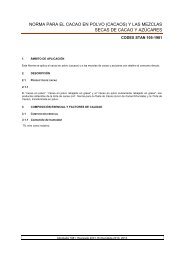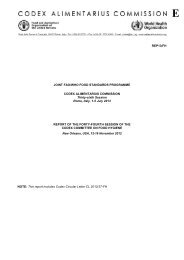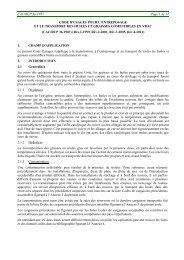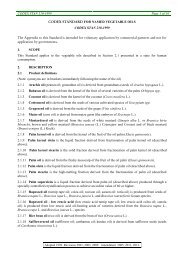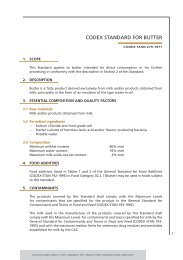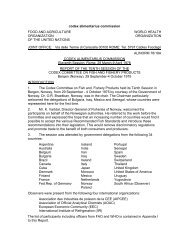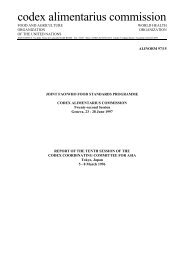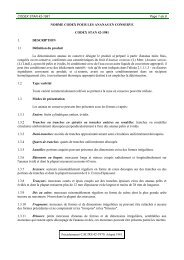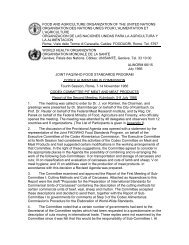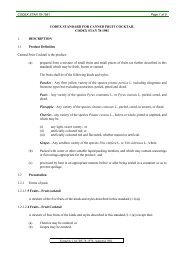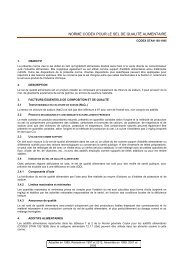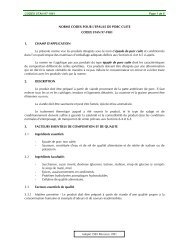codex alimentarius commission FOOD AND AGRICULTURE ...
codex alimentarius commission FOOD AND AGRICULTURE ...
codex alimentarius commission FOOD AND AGRICULTURE ...
You also want an ePaper? Increase the reach of your titles
YUMPU automatically turns print PDFs into web optimized ePapers that Google loves.
naming of "low calorie" and "reduced calorie" foods be replaced by "energy" in<br />
recognition of the increasing use of the SI. System. The Committee agreed to the use of<br />
the term "energy" in order to resolve the problem of the dual use of joule and calorie as<br />
units of measurement of food energy. -The Committee agreed to consider the<br />
development of a standard which would apply only to energy-reduced foods but which<br />
would contain a definition for "low-energy foods". In the claims section of the standard an<br />
appropriate provision could be included which would be consistent with the principle<br />
contained in Section 6.1.3 of the General Standard for the Labelling of and Claims for<br />
Prepackaged Foods for Special Dietary Uses. This Section 6.1.3 permitted claims such<br />
as: "this food is naturally X" but would not allow the food to be described as "special<br />
dietary" or "special dietetic".<br />
70. The Committee decided to restrict the discussion of the draft to major<br />
considerations which would assist the delegation of the USA to prepare a revised text;<br />
this text would be sent to governments for comments prior to the next session of the<br />
Committee: the standard should be for Energy-Reduced Foods. It would be necessary to<br />
develop an appropriate definition, and to determine the extent to which the energy<br />
content of any foods had to be reduced, compared with the comparable ordinary food,<br />
before the food could be regarded as a special dietary food and described as being<br />
energy-reduced. A number of delegations indicated that in their countries regulations<br />
existed which prescribed the extent to which such a reduction in energy was required<br />
before the food could be marketed as an energy-reduced food. The reduction was<br />
normally related to a base reference food and the reduction varied from one-third to 50<br />
percent of the normal energy content. The delegation of France pointed out that<br />
limitation of the energy value only could lead to nutritional imbalances and that it would<br />
therefore be desirable to indicate requirements for the content of certain nutrients. Some<br />
delegations drew attention to the need also to cover specially formulated products for<br />
which there was no base reference food. It was agreed that countries should supply the<br />
delegation of the USA (Dr. Robert Weik) with as much information as possible on the<br />
regulations or practices in their countries relating to energy-reduced foods. The<br />
delegation of the USA undertook to prepare a redraft of the standard and to circulate it<br />
for government comments prior to the next session of the Committee.<br />
DISCUSSION ON THE USE OF THE TERM "PREPACKAGED" IN CODEX<br />
ST<strong>AND</strong>ARDS FOR <strong>FOOD</strong>S FOR SPECIAL DIETARY USES<br />
71. The Secretariat informed the Committee of the work undertaken by Codex<br />
Committee on Labelling on Draft Guidelines for the Labelling of Non-Retail Containers.<br />
The Commission, at its 13th Session, had recognized that Codex Committees could<br />
provide valuable information on this matter and in particular on the definitions of those<br />
types of container to which the guidelines should apply and which were not covered by<br />
the General Standard for the Labelling of Prepackaged Foods (CAC/RS 1-1969).<br />
72. The Committee noted that containers for foods destined for catering purpose,<br />
which would include the use in hospitals, were, at present, not considered to be<br />
"prepackaged" products for the purpose of Codex Standards, but were one of the types<br />
of non-retail containers which were to be covered by the above guidelines. It was further<br />
noted that for certain products, a large proportion of the total production was consumed<br />
under catering arrangements; e.g. hospitals, institutional feeding or restaurants and<br />
canteens.<br />
73. The Committee felt that in addition to labelling considerations there might be<br />
more far- reaching implications concerning the scope of those standards which were



